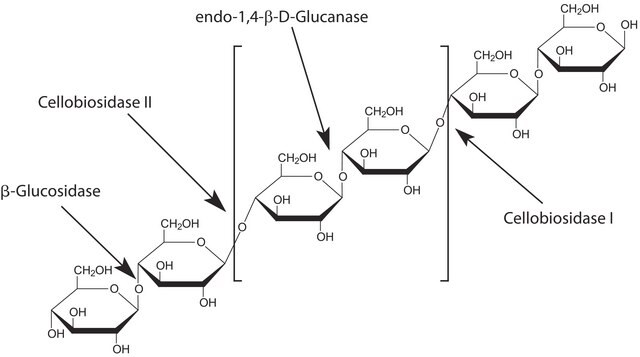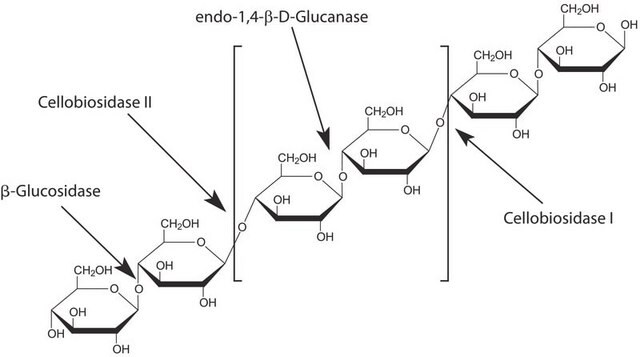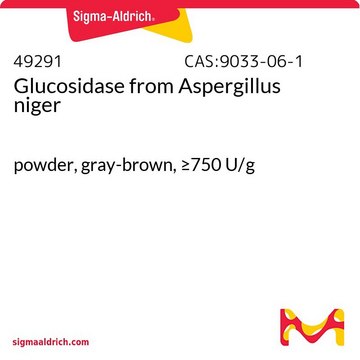C2730
Cellulase from Trichoderma reesei
aqueous solution, ≥700 units/g
Synonym(s):
Celluclast®, Celluclast® 1.5L
Sign Into View Organizational & Contract Pricing
All Photos(3)
About This Item
Recommended Products
biological source
fungus (Trichoderma reesei)
Quality Level
form
aqueous solution
specific activity
≥700 units/g
mol wt
68 kDa
greener alternative product characteristics
Waste Prevention
Design for Energy Efficiency
Learn more about the Principles of Green Chemistry.
sustainability
Greener Alternative Product
density
1.10-1.30 g/mL
greener alternative category
storage temp.
2-8°C
Looking for similar products? Visit Product Comparison Guide
General description
We are committed to bringing you Greener Alternative Products, which adhere to one or more of The 12 Principles of Greener Chemistry. This product has been enhanced for energy efficiency and waste prevention when used in cellulosic ethanol research. For more information see the article in biofiles and Enzymes for Alternative Energy Research.
Cellulase from Trichoderma reesei is produced by submerged fermentation of a selected strain of the fungus Trichoderma reesei and catalyzes the breakdown of cellulose into glucose, cellobiose, and higher glucose polymers. It corresponds to a molecular mass of 68 kDa with optimum pH and temperature of 6 and 52° C, respectively.
Cellulase from Trichoderma reesei is produced by submerged fermentation of a selected strain of the fungus Trichoderma reesei and catalyzes the breakdown of cellulose into glucose, cellobiose, and higher glucose polymers. It corresponds to a molecular mass of 68 kDa with optimum pH and temperature of 6 and 52° C, respectively.
Application
Cellulase from Trichoderma reesei has been used:
- for aqueous extraction of oil from corn germ
- in the enzymatic hydrolysis of Sweet Sorghum Bagasse (SSB)
- in the enzymatic digestion of paper grids
Biochem/physiol Actions
Cellulase complexes with β-glucosidase for degrading cellobiose to glucose polymer. The lignin content in straw and furfural residues hampers cellulase production.
Legal Information
A product of Novozyme Corp.
Celluclast is a registered trademark of Novozymes Corp.
Signal Word
Danger
Hazard Statements
Precautionary Statements
Hazard Classifications
Resp. Sens. 1
Storage Class Code
10 - Combustible liquids
WGK
WGK 1
Flash Point(F)
Not applicable
Flash Point(C)
Not applicable
Personal Protective Equipment
dust mask type N95 (US), Eyeshields, Gloves
Choose from one of the most recent versions:
Already Own This Product?
Find documentation for the products that you have recently purchased in the Document Library.
Customers Also Viewed
Purification and characterization of cellulase from Trichoderma reesei.
Zhu N, et al.
Chinese Journal of Bioprocess Engineering, 8(3), 40-43 (2010)
Lipid production by Cryptococcus curvatus on hydrolysates derived from corn fiber and sweet sorghum bagasse following dilute acid pretreatment
Liang Y, et al.
Applied Biochemistry and Biotechnology, 173(8), 2086-2098 (2014)
Qibo Zhang et al.
Biotechnology for biofuels, 14(1), 194-194 (2021-10-03)
Sunflower stalk pith, residue from the processing of sunflower, is rich in pectin and cellulose, thereby acting as an economic raw material for the acquisition of these compounds. In order to increase the commercial value of sunflower processing industry, a
Abha Sharma et al.
3 Biotech, 10(8), 367-367 (2020-08-25)
Ferulic acid is a known precursor for vanillin production but the significance of agro waste as substrates for its extraction, in combination with microbes is a less explored option. Various lactic acid bacteria were screened for the production of ferulic
Studies on the production and application of cellulase from Trichoderma reesei QM-9414
Krishna SH, et al.
Bioprocess Engineering, 22(5), 467-470 (2000)
Our team of scientists has experience in all areas of research including Life Science, Material Science, Chemical Synthesis, Chromatography, Analytical and many others.
Contact Technical Service










